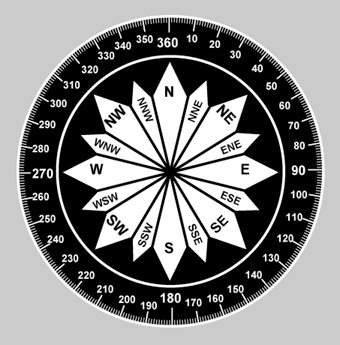A compass is a simple tool that has been around for thousands of years. It uses a free-floating bit of metal that’s been magnetized. The magnetic metal will naturally align with the earth’s own magnetic field, letting us know where north is. We use its markings to figure out not just where we are, but where we are going. When aiming a satellite dish or antennas, we use compass headings to know exactly where to point. You can get these coordinates from the built-in pointing system in the receiver, or using a site like dishpointer.com We’ll say something like, “point the antenna at 270 degrees.”
Which is fine if…
I’m willing to bet that there are very few people reading this article who don’t have a smartphone. And, every smartphone has a compass app within it. A compass is not only a useful thing to have in a phone, but it’s required for the GPS systems that help with locating the phone, as required by law.
When you use a compass app, you’ll get that numerical heading information. But, believe it or not, there are cases when you don’t actually have a phone with you. That means you have to rely on arcane systems like “remembering things” and “math” which are far less common today than in years past.
Supposing you have one of these:
Solid Signal’s Military Grade Compass is an inexpensive way to get compass headings, but it isn’t as easy to read as a smartphone app. It’s only one of the compasses you can buy, and I personally recommend you find the least expensive one possible unless you have a very specific need. All compasses work the same and the ones from the dollar store work just as well as a $400 one, unless you’re on a boat or plane or something like that. Of course, you have to know how to use them. Here’s a quick guide.
Turning around in a circle can be looked at as “going around 360 degrees.” In other words, as you spin, you could stop in any of 360 equally spaced points. If you’re facing north, we call that zero degrees. If you spin around halfway, we call that 180 degrees. and you’re facing south. Here’s how compass directions (like north) translate into numbers, called compass headings.
| North | 0 degrees |
| North-Northeast | 22.5 degrees |
| Northeast | 45 degrees |
| East-Northeast | 67.5 degrees |
| East | 90 degrees |
| East-SouthEast | 112.5 degrees |
| SouthEast | 135 degrees |
| South-Southeast | 157.5 degrees |
| South | 180 degrees |
| South-Southwest | 202.5 degrees |
| Southwest | 225 degrees |
| West-Southwest | 247.5 degrees |
| West | 270 degrees |
| West-Northwest | 292.5 degrees |
| Northwest | 315 degrees |
| North-Northwest | 337.5 degrees |
Here’s a picture if it’s easier for you to visualize it that way.

This kind of simple reference will help you translate the numbers you get from dish aiming apps or from the receiver into general directions. Remember too that those numbers are just a starting point. They’re a way to save time when beginning the aiming process. You’ll probably need to make more adjustments in order to get the perfect satellite picture you want.
Something to think about
A compass is an essential tool for satellite aiming, whether it’s the one on your phone or a traditional one. It’s not the only tool. If you need the kind of equipment the professionals use, shop at Solid Signal for the same kind of tools that pro installers choose. Have questions? We’re here for you. Call 888-233-7563 during East Coast business hours. We’re here with support before, during, and after the sale.

